Strategy, Competition and Sustainability
Introduction
This business report is divided into two main sections to achieve the learning outcomes of the assignment brief. The report will make use of academic models as frameworks and implement them on the organisations in question. Where possible, feasible recommendations will be provided.
The purpose of the first section is to summarise the strategic analyses of Nottingham Arts (NAT) Theatre, which was conducted during the group presentation, build on what research was done overall and improve in areas where required. Then using the analyses the report will focus on the issues and possible recommendations at each strategic level, which would allow the business to be sustainable. This section is in relation to the first two tasks of the assignment brief.
The second section of the report focuses on a comparison between NAT and Derby theatre. After the in depth comparison of both the organisations a possible collaboration is recommended which could benefit both organisations to achieve long term sustainability. This section is in relation to the second two tasks of the assignment brief.
Section – 1
This section of the report covers the summary of the analyses for the Nottingham Arts theatre, which were conducted as part of a group, and then build on the analyses to improve them further. The latter part of this section contains the different approaches that could be used to address the issues within NAT using relevant academic models.
1. Strategic Analyses of NAT:
Strategic analyses are part of any process which involves an action towards the long-term sustainability of any organisation (Bourgeois, 1996). The key strategic analyses are discussed here and some of the key points of the initial group analyses (For detailed group analyses see Appendix) are also discussed and are further improved for a deeper understanding.
(a) External Environment Analyses:
Using the PESTEL (Baines, 2009) and Porter’s five forces (Porter, 1979) frameworks the external analyses to NAT was conducted. Upon applying both the frameworks some important factors were established that would affect NAT currently and over a period of time. The key points of the analyses are as follows:
• Funding cuts of the arts council by 30% could adversely affect NAT’s long term sustainability as securing funding is the key to developing the theatre further
• The technological pressure from 3-D movies and alternative options for the customers. NAT’s current technological portfolio is outdated and with competition moving fast ahead it could be a major long term issue for NA• The current supply chain for NAT and the power of suppliers and customers due to the current position of the theatreUsing Porter’s (1985) five forces a radar plot was drawn to give an idea of the external forces that effect NAT presently and how it could change in the next 1-3 years. It can be seen from the plot that over the next two years almost all the forces will increse thus causing more pressure on NAT.
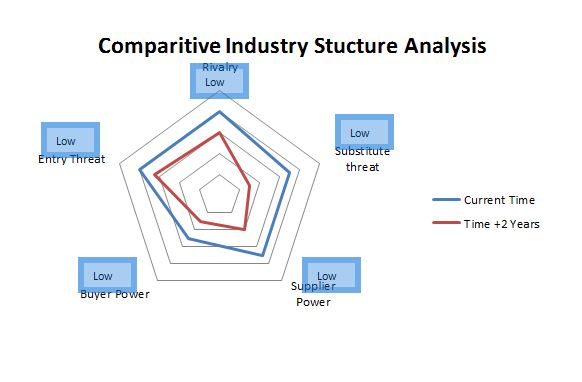 Adapted from Johnson et al (2011)
Adapted from Johnson et al (2011)
(b) Strategic Capabilities:
Strategic capabilities define the possibility of a business for its long-term sustainability (Barney, 2006). VRIN and Components of strategic capabilities frameworks from Johnson et al (2011) were used to determine the strategic capabilities. The VRIN used initially (See Appendix) was expanded as part of this report. The original VRIN considered the historical importance, the distinctive location and the pricing strategy as positives. After further research and looking in-depth it has been realised that due to its current strategy, NAT is losing the distinctive features and will need to work on the mission and vision to develop competitive advantage.
In addition to the VRIN analyses, by using the value chain by Michael Porter (1985) the strategic capabilities of NAT can further be analysed. The following table was developed after applying the value chain analyses on NAT. It can be seen that most of the aspects don’t currently add value to the organisation.
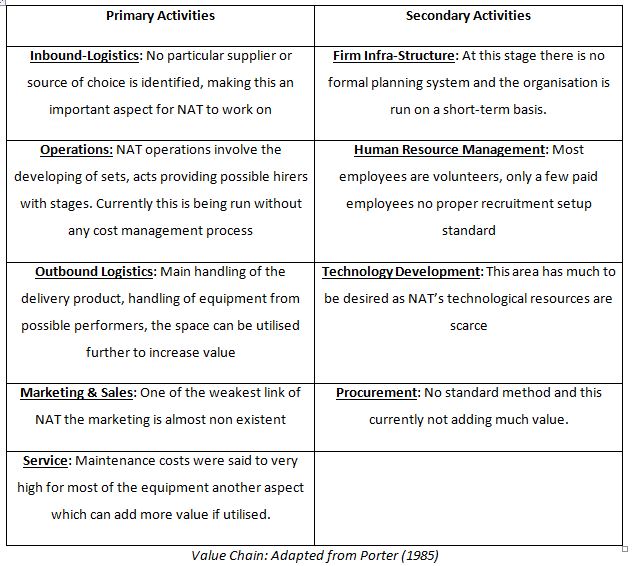
After analysing the strategic capabilities it can be argued that although there is potential in NAT and it has some important competitive capabilities, these are not being used to and extent which could result in long-term sustainability.
(c) Stakeholder Analyses:
In his book about stakeholders in charitable organisations, Ricardo Gomes (2009) states that sometimes the organisation has the perception to lose interest in its stakeholders. Using the stakeholder mapping and corporate governance (See Appendix) from Johnson et al (2011) a stakeholder analyses was conducted to get an idea about identifying the most important people to the organisation. After looking at the stakeholder map for NAT and carrying out discussions with the current staff at the organisation it was observed that very important stakeholders, such as suppliers, were not dealt with properly, and there was also a missing link between the board and the staff, both of which are key players of the organisation and both of which play an important role in the long term sustainability of NAT. The map identifies important people within the organisation. This is then used in the second area of this section to recommend possible ways to keep the key players interested within the organisation.
(d) Success and Sustainability:
After the initial strategic analyses of the current situation at NAT a short conclusion can be put forward, keeping in context the scope of this report. From the analyses it can be seen that NAT is under extreme external pressure with competition rising, substitutes being technologically advanced and cuts in funding. It is very difficult for NAT to build upon its current strategy. At the current stage the organisation is neither successful nor completely failing, but it is battling for survival. Over the course of time the actual strategy and mission of NAT has been left behind. The original mission of NAT to build on its pillars of excellence (See Appendix) has now turned into short term survivability. The graph below illustrates the strategic drift of NAT:
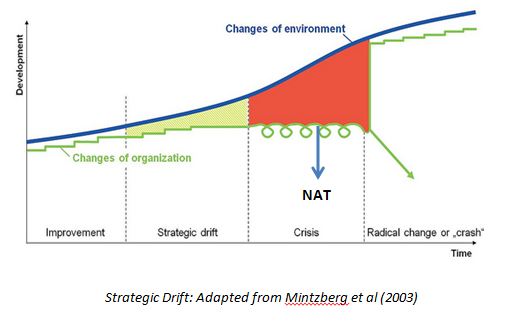
The current position of NAT as shown from the strategic drift figure shows that the organisation is currently in crises and does not have a long-term sustainability plan. The strategic drift has been far too much over the past few years and the theatre needs a transformational change if it is to ensure its survival in the next 1-3 years.
2. NAT Recommendations:
This section of the report covers the possible recommendations after the analyses conducted in the previous part of the report. This section covers recommendations which could be undertaken by NAT on its own, as well as a possible collaborative strategy.
(a) Corporate Level Changes:
Public sector organisations need to be as competitive as private organisations to ensure their existence (Sanchez et al, 2007). After the current strategic analyses and discussion with the staff at NAT, some of the major changes that need to take place for long term sustainability will be at the corporate level. At this stage NAT is working as a single unit and the first step could ensure effective benchmarking is to divide the organisation into two or three business units. After discussion with the operational manager at NAT it was recognised that one of the major profitable areas for NAT is the possibility of renting out the space for different private performances. Another important area is the performing arts section, which is an integral part of the theatre but is not as good in income generation as the rental service. Both of these areas could be divided into separate strategic business units (SBU) which would allow for more accurate benchmarking and then possible improvements in the relevant areas.
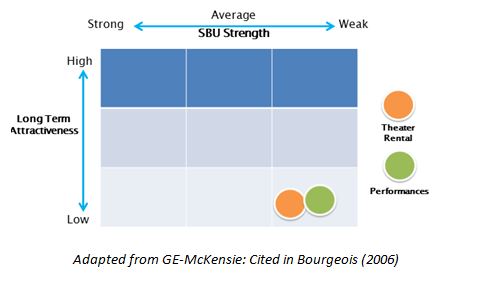 If in the current state the organisation was divided into two business units for illustration purposes, it can be seen by using the McKensie matrix (2006) above that both the units would end up being unsustainable in the next 2-3 years, so the chain needs to go down further to business level once the business units are formed.
If in the current state the organisation was divided into two business units for illustration purposes, it can be seen by using the McKensie matrix (2006) above that both the units would end up being unsustainable in the next 2-3 years, so the chain needs to go down further to business level once the business units are formed.
(b) Business Level Changes:
The importance of business unit effectiveness is crucial for any public or private sector organisation to survive (Kownatzki et al, 2009). The corporate strategy of SBU’s can only work if at business level these units have a distinct and effective strategy in place. By using Porter’s (1998) generic strategy for the analyses it was recognised that NAT was operating a cost-leadership strategy which has not been effective as the current state of sustainability is not satisfactory (See Appendix). To improve on the business strength the strategic clock model from Faulkner and Bowman (1995) was adapted as illustrated below:
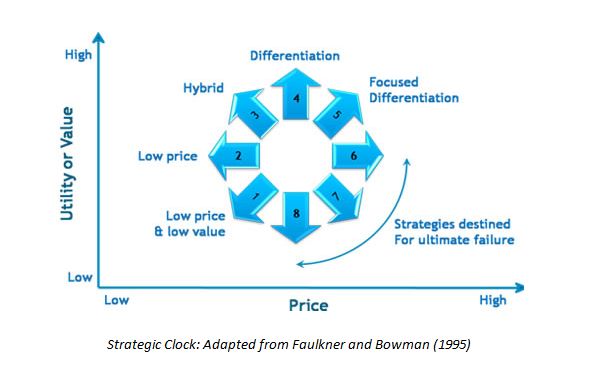 Using the strategic clock the business units can adapt to the requirements and move towards a hybrid strategy of differentiation and low price. This type of strategy will help move towards a more sustainable audience rather than the current low price low value strategy, which is only providing short term survival to the organisation.
Using the strategic clock the business units can adapt to the requirements and move towards a hybrid strategy of differentiation and low price. This type of strategy will help move towards a more sustainable audience rather than the current low price low value strategy, which is only providing short term survival to the organisation.
(c) Operational Level Changes:
It is essential that the aims at top level are transferred to the roots of the organisation for success and sustainability. Operational level is the key for cost management, effective communication with the stakeholders and development of brand image. The Porter’s (1985) value chain for NAT earlier showed that there are some loopholes within the organisation’s supply chain network and this is something that needs to be addressed operationally. The division of business units would mean further micro benchmarking within the organisation at operational level for effective cost management. The brand image of NAT is dependent on the operational efficiency and effectiveness and this also needs to be addressed for better top to bottom strategic integration.
It is important that all three levels of strategy are integrated effectively to enable vertical and horizontal integration within the organisation (Govindahajan, 1986).
(d) Funding and Other Issues:
Being a charitable organisation government funding is a key aspect of NAT and with the current cuts in funding it is important for them to try and achieve as much government funding as possible, which could address the issue of renovation. To get funding it is important that NAT diversifies its current products and offers distinct services.
Apart from funding, the serious issue of parking needs to be addressed as this is key to attracting customers. Internal decoration, promotion and renovation of the theatre is also required, all of which can come into effect once NAT secures a significant amount of funding.
Section – 2
This section of the report briefly analyses Derby Theatre and some of its key resources and capabilities. NAT and Derby theatres are then compared, which allows an insight into benchmarking organisations that are in a similar industry. In the final part of this section the possibility of collaboration between the two theatres will be critiqued.
3. Derby Theatre:
Derby theatre is a charity that is now a part of University of Derby and has a vision to create a ‘learning theatre’ (www.derbytheatre.co.uk). The theatre is situated in the heart of the city centre and is the leading theatre within Derby. During the visit to the theatre there was a detailed discussion with the manager, where some of the key factors of the theatre were noted. These included having the latest technology in the performing arts industry, being the only such establishment to be a part of a university and offering professional and critically acclaimed plays to the public. It was also shown that the theatre is fully booked and is receiving further requests for the next two years. Clearly the theatre is a running business, but according to the operational manager, even with such a high demand the organisation is failing to make a surplus.
4. Comparison of the Theatres:
To understand the position of both the theatres and to compare them both internal and external analyses were undertaken, which are explained as follows.
(a)Internal analyses:
The internal analyses were done to compare the internal environment, resources within the organisations and the culture that is a part of the organisation. All of these factors have an important influence on the corporate performance of an organisation.
(i) Organisational Culture:
The culture within the organisation governs the development of the organisational strategy (Kaplan, 2011). To analyse the organisational culture the cultural web (Johnson et al, 2011) was used to assist in the key areas. Although a full cultural web was not drawn the key points from within the frame work were used to compare the organisations.
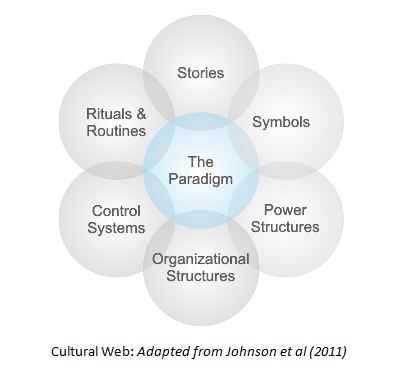
Although both the organisations are charities they exhibit different cultures within them. The organisational structure within Derby theatre is formal and has a defined system, NAT in contrast has an informal structure where both paid and volunteered employees take part. The power for Derby is exhibited by the university while NAT is governed by a set board of directors. Derby theatre is very popular and thus the quality control system to maintain a standard resides within the employees. NAT on the other hand are offering value for money operations, which develops a quantity rather than quality mind-set within the organisation. During the visit to Derby theatre it was felt that the theatre is not pushing towards making a surplus even with full capacity, thus generating a go as you can culture within the organisation. NAT on the other hand is fighting for survival and the normal response from the management was that the pressure to get a surplus was very high. Overall, even though both the organisations are in the same industry, the culture with the organisation is very different in terms of values, beliefs and behaviours.
(ii) Resource Based View:
In terms of the resources the two organisations are very different and are explained below:
• Derby theatre is at the heart of the city and is the leading performing arts venue in Derby. In contrast NAT is also at a prime location but is a follower rather than a leader in the region
• Technological facilities within Derby theatre are far more advanced than those present at NAT
• The current building and the state of Derby theatre is also much more attractive than NAT
• NAT has a unique history and is distinctive in that aspect
• The financial state of NAT in contrast to Derby theatre is not very convincing, as Derby theatre is supported by the University it is more likely to get funding
• Workforce at Derby theatre is enough to run the theatre and the operations smoothly, NAT on the other hand has limited employees but most of them being volunteers have a high level of motivation
The few points above explain some of the resource comparison between NAT and Derby theatre. It can be clearly concluded that in terms of resource based competences Derby theatre is far more progressive than NAT.
(b) External Analysis:
The external analysis of NAT was conducted using PESTEL and Porter’s five forces (1985) initially. To compare and contrast this further if both the same frame works are applied to Derby theatre most of the PESTEL analyses result in same forces. Another framework which was used to analyse the external forces further was strategic groups. NAT is a follower and is competing with two major competitors in Nottingham, which don’t fall directly into NAT’s strategic group but due to NAT’s current situation are effecting the strategic capability of the theatre. On the contrary Derby theatre is the market leader in the local region and does not have any direct competition in performing arts. The main threat is cinemas, but even those don’t directly affect Derby theatre.
Another important aspect of external comparison is the partnership each organisation has which significantly impacts the strategic capabilities. Derby theatre has direct links with University of Derby and Derby Live, providing them marketing and expansion capabilities. This also allows them to reach a wider audience. NAT on the contrary has links with a local educational institution but the partnerships are informal and if expanded further can allow NAT to reach a wider audience.
5. Collaboration (NAT & Derby Theatre):
After conducting the analyses and the comparison of both NAT and Derby theatre a possibility of collaboration will be critiqued in this section. The main options that could be considered for synergy development are:
• Mergers & Acquisitions
• Strategic Alliances
(a) Mergers & Acquisitions (M&A):
The possibility of an acquisition could only happen if Derby theatre was willing to take over NAT, which in the current situation looks highly unlikely. Acquisitions are normally driven by money and the strategic fit nature of the organisations (Yu et al, 2011). The current state of NAT is does not make it a suitable candidate for Derby theatre to invest in. On the other hand a merger between Derby theatre and NAT also seems a slim possibility. Although by merging or acquiring an organisation an organisation might have the option to extend, consolidate and increase its capabilities it something that involves risk and careful management (Johnson et al, 2011). According to Mehta & Hirshheim, 2007 more than 40% of mergers and acquisitions result in failures. This is something that would keep both the theatres away from a possibility of any such move.
Even though there are many negative aspects of M&A there are critical success factors which can benefit both the organisations in long term sustainability and help in expanding their market share and presence. Vanpoucke (2010) states that mergers and acquisitions are the short cut to increased market share and brand expansion
Although this approach has its positive and negative aspects the current situation of both the theatres would not allow such a move and according to the research conduct there is a highly likely chance of failure of a merger and acquisitions within NAT and Derby theatre.
(b) Strategic Alliance:
A low risk approach to expand a profile of any organisation is by forming a strategic alliance (Mehta & Hirschheim, 2007). Being a low risk approach this could be something that would interest both the theatres as in this case the organisations would not have to complexly merge with each other. This type of move would allow Derby theatre to expand its presence in Nottingham and use the venue as a stage for student performances for the University for a non-local exposure. NAT could use the alliance to allow some external funding and support from Derby theatre which could help in renovating the theatre. Being associated with Derby theatre would also allow NAT to have a better brand image.
Although this approach has its positives there is still a high possibility of failure, up to 50% of strategic alliances fail (Johnson et al, 2011). Yu et al (2011) states that although an alliance has a lower risk, this does not guarantee management and control problems within the two organisations. But even with the high failure rate alliances are the best way to go forward where uncertainty is high (Johnson et al, 2011).
From the argument above and keeping in context both the theatres it is possible to develop positive synergy through the strategic alliance route. Although this route is not risk free it is one of the best ways to go forward for both the organisations to increase their presence in the market and achieve long term sustainability.
6. Conclusion:
After analysing the given organisation it can be seen that strategy plays a key role in the development and long term objectives of any organisation. NAT and Derby theatre are two charity organisations but are very different from each other, as was shown through the research for the report.
An important aspect of the research was looking at both organisations and concluding that strategy is not stable and needs to change dynamically depending on the environment and the conditions within the organisation.
7. References:
• Bourgeous,L.J.(2006). Strategic Management from Concept to Implementation. Dryden
• Cambell, D, Stonehouse, G ,and Houston, B, (2008) Business Strategy, 2nd ed, Prentice Hall,London
• Christopher,M.(1998). Logistics and Supply Chain Management, 2nd ed, Prentice Hall,New York
• DeSarbo, W, & Grewal, R 2008, ‘Hybrid strategic groups’, Strategic Management Journal, 29, 3, pp. 293-317
• DeSarbo, W, Grewal, R, & Wang, R 2009, ‘Dynamic strategic groups: deriving spatial evolutionary paths’,Strategic Management Journal, 30, 13, pp. 1420-143
• Faulkner D and Bowman C, (1995) The Essence of Competitive Strategy, Prentice Hall, 1995
• Gomes, R (2009) Stakeholder Analysis and Public Sector Organizations: Are stakeholders really important to public sector organizations?, VDM Verlag, New York
• Govindahajan, V 1986, ‘Decentralization, Strategy, and Effectiveness of Strategic Business Units in Multibusiness Organizations’, Academy of Management Review, 11, 4, pp. 844-856
• Greasley, A. (2008) Operations Management, SAGE Publications, London
• Johnson,G, Whittington,R and Scholes,K (2011). Exploring Strategy,London, FT: Prentice Hall
• Kaplan, S 2011, ‘Strategy and PowerPoint: An Inquiry into the Epistemic Culture and Machinery of Strategy Making’, Organization Science, 22, 2, pp. 320-346
• KOWNATZKI, M, WALTER, J, & LECHNER, C 2009, ‘THE CORPORATE CONTEXT AND THE SPEED OF SBU-LEVEL DECISION MAKING’, Academy of Management Annual Meeting Proceedings, pp. 1-6, Business Source Premier
• Mehta, M, & Hirschheim, R 2007, ‘Strategic Alignment In Mergers And Acquisitions: Theorizing IS Integration Decision making’, Journal of the Association for Information Systems, 8, 3, pp. 143-174
• Sanchez-Peinado, E, Pla-Barber, J, & Hébert, L 2007, ‘Strategic Variables That Influence Entry Mode Choice in Service Firms’, Journal of International Marketing, 15, 1, pp. 67-91
• Souitaris, V, & Maestro, B 2010, ‘Polychronicity in top management teams: The impact on strategic decision processes and performance of new technology ventures’, Strategic Management Journal, 31, 6, pp. 652-678
• Vanpoucke, E, & Vereecke, A 2010, ‘The predictive value of behavioural characteristics on the success of strategic alliances’, International Journal of Production Research, 48, 22, pp. 6715-6738
• Yu, J, Gilbert, B, & Oviatt, B 2011, ‘Effects of alliances, time, and network cohesion on the initiation of foreign sales by new ventures’, Strategic Management Journal, 32, 4, pp. 424-446